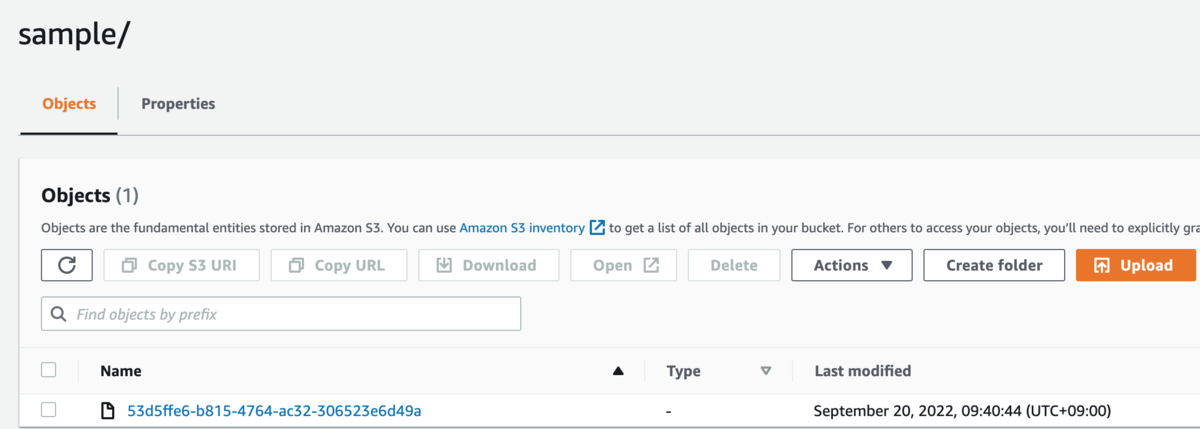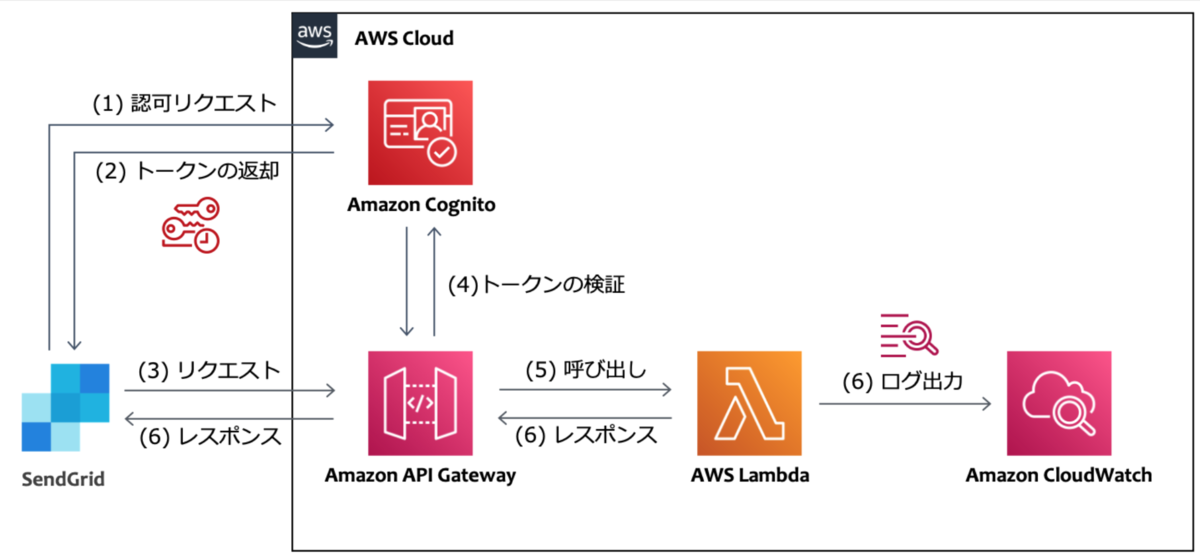SendgridのEvent WebhookログをAWSに連携する

sendgridを利用しており送信履歴をログに残したい要件がありました。
対応する機能としてSendgridではWebhook機能があり、
メールを送信や開封等のイベントを
指定のエンドポイントに送信できます。
サンプルの構成
実際の構成はどのようになるかと言うと、
公式のブログにサンプル構成があり、
こちらがとても参考になりました。
ただ、何点か構成を変更したい点がありました。
構築したい構成
 上記サンプルとの違いは下記です
上記サンプルとの違いは下記です
ログはS3に格納する
数量が膨大になりそうでしたので、より料金単価が安いS3にしました。
Lambdaを利用しない(apigatewayとs3を直接連携)
背景として、今回のケースではメールのイベントログを格納したいだけであり、
何か加工等の特別な処理をさせたい訳でなかったため、
Lambdaを利用する必要がありませんでした。
Lambda経由でS3に格納しても要件実現はできてしまうのですが、
特に、Lambdaのスケーラビリティを心配したくないことや、
ソース管理の必要があるといったデメリットを抱えてしまうため
利用しない形としました。
CDKで書きたい
サンプルで書いてみました。
apigateway周りでもう少し細かい設定を付与したいですが、
最低限のものとお考えください。
import { Stack, StackProps, RemovalPolicy, aws_apigateway as apigateway, aws_s3 as s3, aws_iam as iam, aws_certificatemanager as acm, aws_route53 as route53, aws_cognito as cognito, aws_route53_targets as targets, } from 'aws-cdk-lib'; import { Construct } from 'constructs'; const scopeName = 'activity'; type Props = { hostedZoneId: string; domainName: string; domainPrefix: string; bucketName: string; } & StackProps; export class SendgridWebhookS3Stack extends Stack { constructor(scope: Construct, id: string, props: Props) { super(scope, id, props); const { hostedZoneId, domainName, domainPrefix, bucketName } = props; const bucket = new s3.Bucket(this, 'Bucket', { bucketName: bucketName, removalPolicy: RemovalPolicy.DESTROY, }); const fullAccessScope = new cognito.ResourceServerScope({ scopeName: '*', scopeDescription: 'Full access' }); const pool = new cognito.UserPool(this, 'Pool', { removalPolicy: RemovalPolicy.DESTROY, }); const resourceServer = pool.addResourceServer('ResourceServer', { identifier: scopeName, scopes: [fullAccessScope], }); pool.addDomain('CognitoDomain', { cognitoDomain: { domainPrefix: domainPrefix, }, }); pool.addClient('appClient', { generateSecret: true, oAuth: { flows: { clientCredentials: true, }, scopes: [cognito.OAuthScope.resourceServer(resourceServer, fullAccessScope)], }, }); const auth = new apigateway.CognitoUserPoolsAuthorizer(this, 'Authorizer', { cognitoUserPools: [pool], }); const restApiRole = new iam.Role(this, 'Role', { assumedBy: new iam.ServicePrincipal('apigateway.amazonaws.com'), path: '/', }); bucket.grantReadWrite(restApiRole); const hostedZone = route53.HostedZone.fromHostedZoneAttributes(this, 'HostedZone', { hostedZoneId: hostedZoneId, zoneName: domainName, }); const certificate = new acm.Certificate(this, 'Certificate', { domainName: `*.${domainName}`, validation: acm.CertificateValidation.fromDns(hostedZone), }); const api = new apigateway.RestApi(this, 'RestAPI', { domainName: { domainName: `${domainPrefix}.${domainName}`, certificate: certificate, }, // disableExecuteApiEndpoint: true, defaultCorsPreflightOptions: { allowOrigins: apigateway.Cors.ALL_ORIGINS, allowMethods: ['POST', 'OPTIONS'], statusCode: 200, }, endpointConfiguration: { types: [apigateway.EndpointType.REGIONAL], }, }); const items = api.root.addResource('logs'); const prefix = items.addResource('{prefix}'); // オブジェクトをアップロードするための PUT メソッドを作成する prefix.addMethod( 'POST', new apigateway.AwsIntegration({ service: 's3', integrationHttpMethod: 'PUT', // アップロード先を指定する path: `${bucket.bucketName}/{prefix}/{fileName}`, options: { credentialsRole: restApiRole, passthroughBehavior: apigateway.PassthroughBehavior.WHEN_NO_MATCH, requestParameters: { // メソッドリクエストのパスパラメータを統合リクエストのパスパラメータにマッピングする 'integration.request.path.prefix': 'method.request.path.prefix', 'integration.request.path.fileName': 'context.requestId', }, integrationResponses: [ { statusCode: '200', responseParameters: { 'method.response.header.Timestamp': 'integration.response.header.Date', 'method.response.header.Content-Length': 'integration.response.header.Content-Length', 'method.response.header.Content-Type': 'integration.response.header.Content-Type', 'method.response.header.Access-Control-Allow-Headers': "'Content-Type,Authorization'", 'method.response.header.Access-Control-Allow-Methods': "'OPTIONS,POST,PUT'", 'method.response.header.Access-Control-Allow-Origin': "'*'", }, }, { statusCode: '400', selectionPattern: '4\\d{2}', responseParameters: { 'method.response.header.Access-Control-Allow-Headers': "'Content-Type,Authorization'", 'method.response.header.Access-Control-Allow-Methods': "'OPTIONS,POST,PUT'", 'method.response.header.Access-Control-Allow-Origin': "'*'", }, }, { statusCode: '500', selectionPattern: '5\\d{2}', responseParameters: { 'method.response.header.Access-Control-Allow-Headers': "'Content-Type,Authorization'", 'method.response.header.Access-Control-Allow-Methods': "'OPTIONS,POST,PUT'", 'method.response.header.Access-Control-Allow-Origin': "'*'", }, }, ], }, }), { authorizer: auth, authorizationScopes: [`${scopeName}/*`], requestParameters: { 'method.request.path.prefix': true, 'method.request.path.fileName': true, }, methodResponses: [ { statusCode: '200', responseParameters: { 'method.response.header.Timestamp': true, 'method.response.header.Content-Length': true, 'method.response.header.Content-Type': true, 'method.response.header.Access-Control-Allow-Headers': true, 'method.response.header.Access-Control-Allow-Methods': true, 'method.response.header.Access-Control-Allow-Origin': true, }, }, { statusCode: '400', responseParameters: { 'method.response.header.Access-Control-Allow-Headers': true, 'method.response.header.Access-Control-Allow-Methods': true, 'method.response.header.Access-Control-Allow-Origin': true, }, }, { statusCode: '500', responseParameters: { 'method.response.header.Access-Control-Allow-Headers': true, 'method.response.header.Access-Control-Allow-Methods': true, 'method.response.header.Access-Control-Allow-Origin': true, }, }, ], } ); new route53.ARecord(this, 'ARecod', { zone: hostedZone, recordName: `${domainPrefix}.${hostedZone.zoneName}`, target: route53.RecordTarget.fromAlias(new targets.ApiGateway(api)), }); } }
結果確認
作成されたcognitoからclientIdとsecretを取得し、
下記の要領でリクエスト実行します。
<>で囲んだ部分はcdkで指定した値に読み替えてください。
DOMAIN=https://<domainPrefix>.auth.ap-northeast-1.amazoncognito.com
APP_CLIENT_ID=xxxxxx
APP_CLIENT_SECRET=xxxxx
curl -s -X POST ${DOMAIN}/oauth2/token \
-H "Authorization: Basic $(echo -n ${APP_CLIENT_ID}:${APP_CLIENT_SECRET} | base64 )" \
-H "Content-Type: application/x-www-form-urlencoded" \
-d "grant_type=client_credentials" \
-d "client_id=${APP_CLIENT_ID}"
curl -X POST 'https://<domainPrefix>.<domainName>/logs/<prefix>/' \
--header "Authorization: Bearer xxxxxxxxxxx" \
--data '{"message":"Hello"}'
S3にログが格納されていることを確認できました。
S3内ではprefixで指定した文字列の配下にログが格納されます。
下記はprefixにsampleを指定した場合の例です。

おまけで、SendgridではSubuserという機能があり、
論理単位でログの出力を複数設定することができます。
そのため、特定用途のメールのみprefixを分けて
ログ出力するといったことも可能で下。
sendgrid.kke.co.jp
